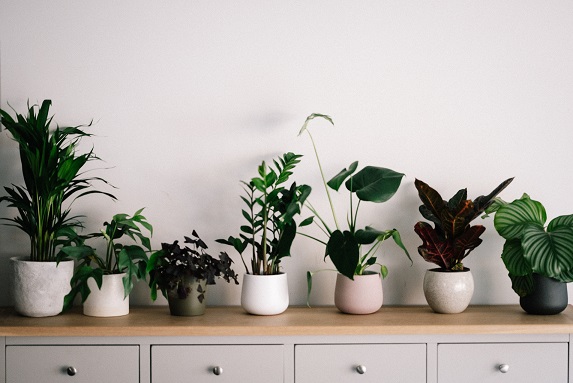Plants might be a fantastic help for your problems if you are unhappy with your home décor. Plants add color and fresh air to the home, as well as some wonderful scents. Here are some examples of plant varieties that you may use in your house.
1. Ficus Pumila
Ficus pumila is a vine-like plant that grows to a height of 10 to 15 feet tall and a width of 3 to 6 feet in its mature condition; it grows to a height of 3 to 10 feet in its early developmental stage. The plant thrives in partial shade and prefers a well-drained, well-aerated soil type; it also thrives in neutral or slightly acidic soils. Despite generating seeds, Ficus Pumila rarely blossoms. They are native to Asia, notable regions of Central and Southern Eastern Asia, such as China. Small growth numbers can also be noted in the Southeast and South Central United States. If you consider getting one, we will try to explain how to grow Ficus pumila, and then you can try implementing those tips to have a healthy plant. When grown indoors, they require plenty of relatively unfiltered sunshine as well as a well-watered, well-drained, and adequately aerated soil that receives regular watering. They also require proper pruning to remove vestigial parts that deplete vital nutrients.
They attract insects and are a good host for butterfly eggs and larvae, which is a common problem. They’re perfect for an oversupply of butterflies. As they grow into brick walls, they leave scars on painted surfaces and holes in them. Apart from being harmful, its canopy-like structure encourages infection and goes undiscovered for long periods. As a result, other plants in the house are easily infected.
2. Aloe Vera
The aloe vera plant is a simple succulent that makes an excellent indoor plant. Aloe vera plants are also valuable because the juice from their leaves can be administered externally to treat pain from cuts and burns. Before you go out and buy aloe, bear in mind that it will need to be planted in a location that receives lots of bright, indirect sunlight. Direct sunshine can dry out the plant and turn the fleshy leaves yellow, so if your aloe is in a particularly sunny position, you may need to water it more frequently. It is critical to select the appropriate container. Use a potting mix designed for cactus and succulents that drains well. Gardening soil should not be used.
Aloe vera gel can be applied topically, however, it should not be consumed by humans or pets. It can induce unpleasant side effects including nausea and indigestion, and it can even be toxic in big doses.
3. Moth Orchid
Moth orchids are gorgeous throughout the year, but they’re especially attractive on chilly days when you’ll be spending a lot of time indoors. Their exquisite blossoms can beautify your home’s tables and windowsills for months. The great news is that they don’t require much to thrive inside. Overwatering rather than underwatering is more likely to destroy a moth orchid. Orchids are commonly grown on bark or sphagnum moss, both of which must be left to dry between waterings.
4. Lucky Bamboo
This plant can be frequently seen in offices and homes. If you decide to get one, you should know that your lucky bamboo needs special care so that it can grow, which includes securing adequate light, water, potting material, fertilizer, and temperature. There’s not much else you can do to damage a fortunate bamboo plant, which is great news for unskilled gardeners or lazy waterers.
5. Croton
Croton plants are a broad genus of houseplants with a wide range of uses. The croton indoor plant has a reputation for being fussy, but if you know how to properly care for a croton houseplant, it can be a hardy and difficult-to-kill plant. Croton plants dislike being moved, and when they are, they can quickly get stressed, resulting in leaf loss. As a result, it’s best to keep the plant as still as possible. If you must move the plant (such as when you buy one), don’t be concerned about the loss of leaves.
6. Paddle Plant
The paddle plant is a large, circular succulent with pink tips on its leaves. These plants prefer intense light, so place it on a sunny windowsill to soak up as much as possible. These plants prefer to be a little drier, so don’t worry if you forget to water them now and again – they will live!
Plants provide a pleasant atmosphere in your house, and you may grow to appreciate them as you care for them. You must take appropriate care of them, just as you must take proper care of everything else if you want to reap the benefits of your effort.

